
55 years ago a young patient and I were standing in the sun just outside the clinic doorway when a butterfly alighted on my left ear. “Yes, I would like to try an IUD” the patient said, amazed and apparently encouraged by the butterfly.
It was the summer between my 3rd and 4th years of medical school. My new wife and I were having a wonderful adventure at the Moravian Hospital in Puerto Cabezas, Nicaragua. The patient I had been persuading to try an IUD was also newly married and wanted something to keep from conceiving right away. She didn’t think her husband would approve of using birth control, however.
“If you had an IUD, he wouldn’t know about it unless you told him,” I had encouraged her. Apparently, the butterfly landing on my ear was the deciding factor, and I was able to insert a Lippes loop.
Hiding contraceptive use is a common strategy in many countries where patriarchy rules. Men in patriarchal societies usually desire large families, and don’t want their partners to make decisions about childbearing. Research has found that covert use of contraception is common in some African countries, especially for wives of polygamous marriages. As many as a third of women in some places conceal their use of birth control! Although I am certain that some women in the USA use contraception without their partner’s knowledge, I have not been able to find a study of its prevalence in this country.
Some birth control methods are easier to hide than others. A pack of pills would be easy to conceal, but it would be a dead giveaway if found. DepoProvera® shots are effective for 3 months and are easy to keep secret. A wife could go into town to shop, as usual, but also stop at the health clinic for her birth control shot. Indeed, some women have stated that is one of the reasons they chose thei method.
There is a new form of DepoProvera® that is packaged so that a woman can give it to herself at home. It is small enough that the pre-filled injection unit would be easy to conceal. Large studies in African countries have found women like this formulation, but unfortunately Sayana®Press is not available yet in the USA. There are other LARCs (Long-Acting Reversible Contraception): Nexplanon®, good for 3 years, and several IUDs, which last up to 10 years, are all easily concealed.
I do not recommend covert use of contraception. However, in some cases it is the only way that women can avoid unwanted pregnancies. Since the majority of family planning methods are female-controlled, the wife should—and can (by hiding her birth control)—have the last word about childbearing.
It only seems right that women should decide about family planning since birthing and most of the responsibilities for childcare rest on women’s shoulders. However, it is best if husbands and wives talk about whether to use contraception, and together choose the method that would be best. This is supported by a statement of friend, Dr. Stan Becker, who has studied reproductive health decisions among couples: “…reproductive health interventions that target couples are found to be more effective than those directed to only one sex.”
However, we don’t live in a perfect world—unfortunately, there are many couples where power and decision-making are not shared. Since family planning is recognized as potential driver of women’s autonomy and health, covert use of family planning can be seen as a symbol of agency for the women in these relationships.
© Richard Grossman MD, 2024
